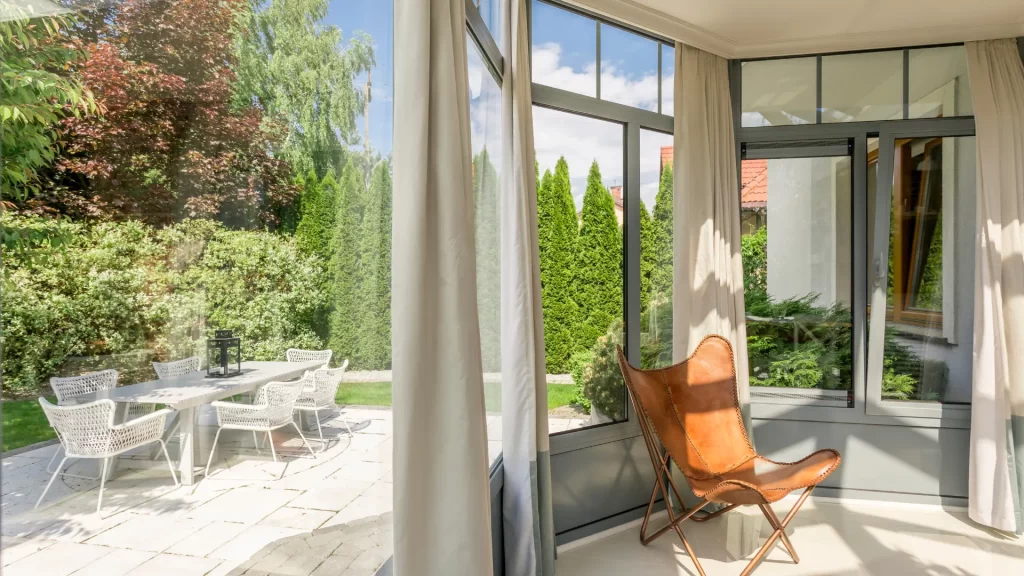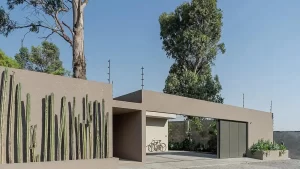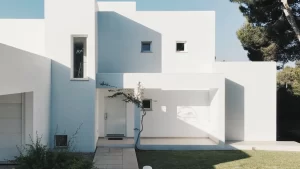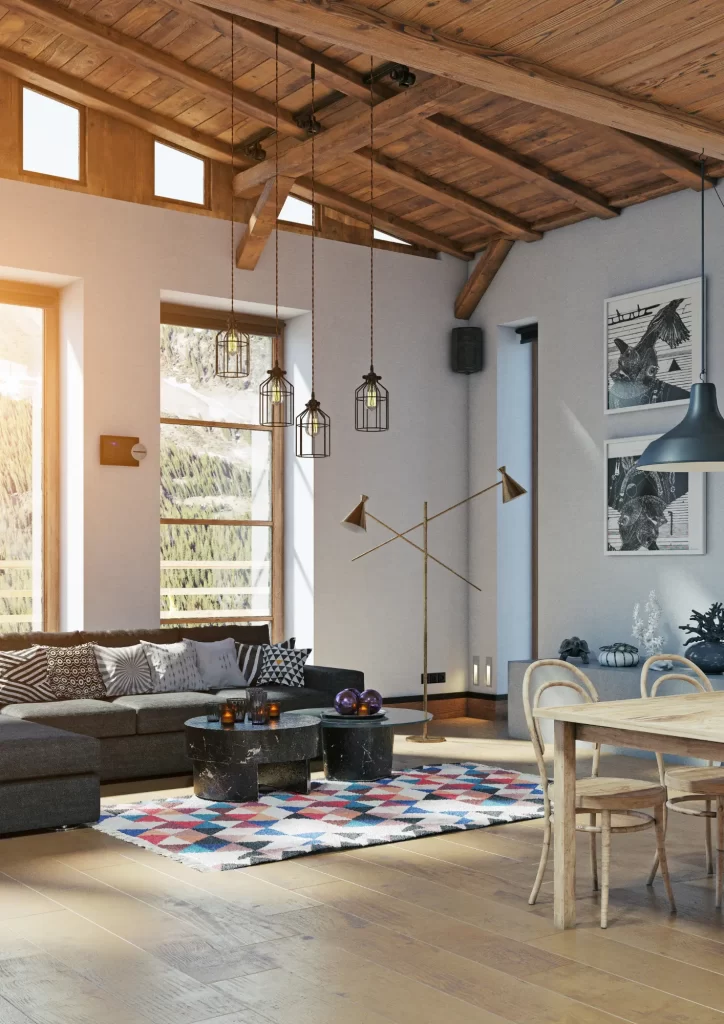In a world of constant stimulation and overwhelming choices, minimalist design stands out as a beacon of simplicity and tranquility. Embracing the essence of “less is more,” minimalist design strips away unnecessary elements to create spaces that are both visually appealing and highly functional. This approach to home design focuses on clean lines, open spaces, and a restrained color palette to foster a sense of calm and harmony.
In this guide, we’ll delve into the core principles of minimalist design and explore how you can incorporate this aesthetic into your dream home. From architectural features to furniture choices and organizational strategies, you’ll discover the beauty and benefits of minimalist living. Let’s embark on a journey of simplicity and elegance as we explore the world of minimalist design for your home.
The Essence of Minimalist Design: Understanding Its Core Principles
Minimalist design is not just about removing clutter; it’s a philosophy that embraces simplicity, functionality, and mindfulness in every aspect of your home. Here are the core principles that define minimalist design:
- Simplicity: Minimalist design is characterized by simplicity in form, color, and texture. Clean lines, uncluttered spaces, and a limited color palette contribute to a sense of calm and order.
- Functionality: Every element in a minimalist home serves a purpose. Furniture and decor items are carefully chosen for their functionality and practicality, reducing unnecessary clutter and promoting efficient use of space.
- Openness: Minimalist design often incorporates open floor plans and ample natural light to create a sense of openness and spaciousness. This enhances the flow of energy and fosters a feeling of freedom and relaxation.
- Quality over Quantity: Rather than filling your home with an abundance of furniture and decor, minimalist design prioritizes quality over quantity. Investing in well-crafted, timeless pieces can make a more significant impact than a multitude of lesser-quality items.
- Balance and Harmony: Minimalist design seeks to achieve a harmonious balance between different elements in the space. This includes balancing negative space (empty areas) with functional areas, as well as balancing visual weight and proportions for a cohesive look.
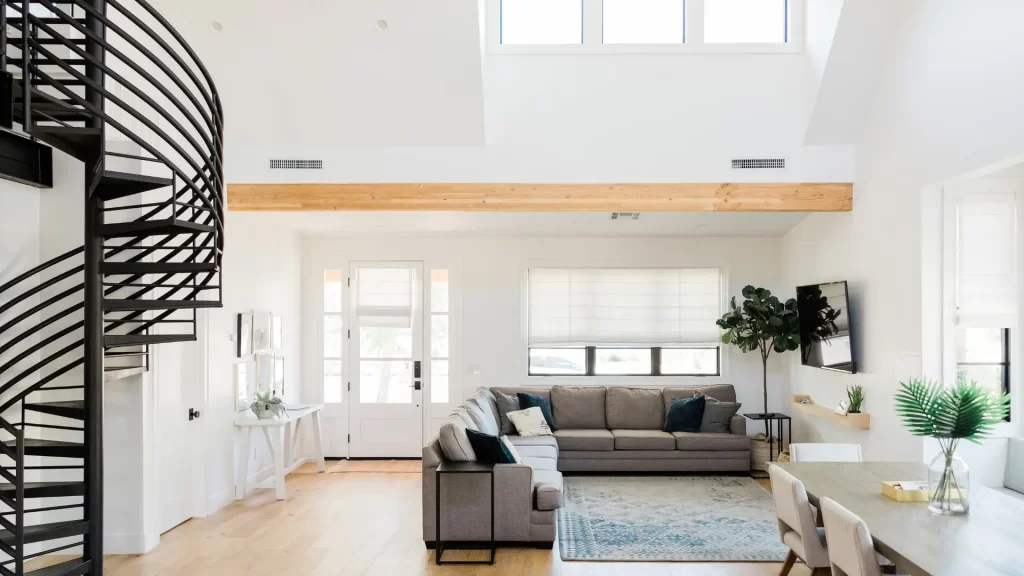
Functionality Over Frills: Practical Elements of Minimalist Home Design
Minimalist home design prioritizes functionality and purposeful elements over unnecessary frills and decorative accents. Here are key practical elements that define minimalist living:
- Multi-Functional Spaces: Minimalist homes often feature multi-functional spaces that serve multiple purposes. For example, a dining area may double as a workspace, or a sofa may include hidden storage compartments.
- Efficient Storage Solutions: Minimalist design emphasizes efficient storage solutions to minimize clutter and maintain a clean aesthetic. Built-in cabinets, shelving units, and concealed storage options help keep belongings organized and out of sight.
- Streamlined Furniture: Furniture in minimalist homes is selected for its functionality and simplicity. Pieces with clean lines, compact designs, and multi-purpose functionality are preferred over bulky or ornate furniture.
- Minimal Decor: Decorative elements in minimalist homes are kept to a minimum to avoid visual clutter. Each decor item serves a purpose and contributes to the overall aesthetic without overwhelming the space.
- Integrated Technology: Technology is seamlessly integrated into minimalist homes to enhance functionality and convenience. Smart home systems, hidden wiring, and minimalist electronic devices contribute to a streamlined and efficient living environment.
- Easy Maintenance: Minimalist design often incorporates materials and finishes that are easy to clean and maintain. This reduces the time and effort required for upkeep, allowing homeowners to focus on enjoying their space without unnecessary chores.
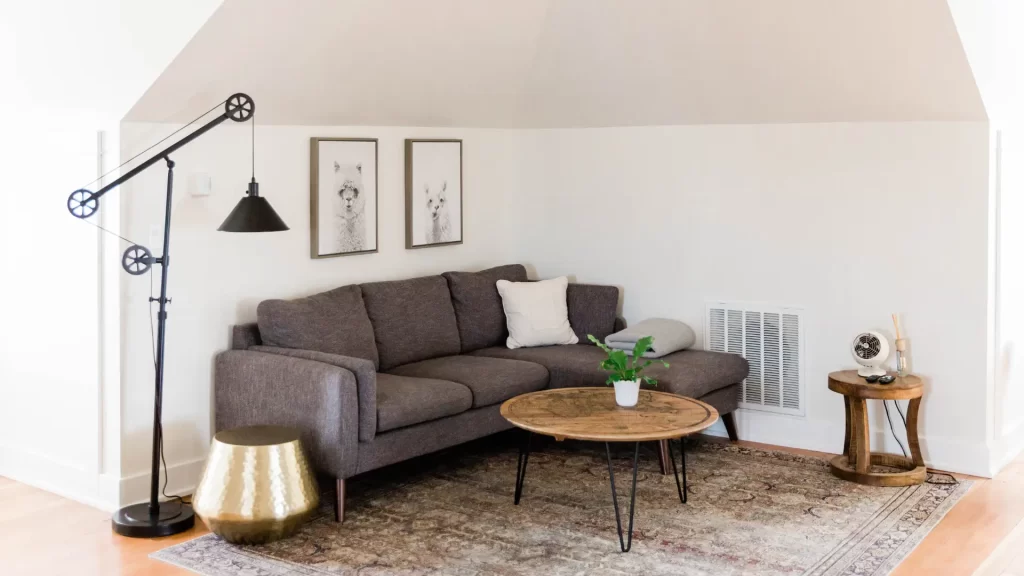
Clean Lines and Open Spaces: Architectural Features in Minimalist Homes
One of the defining characteristics of minimalist homes is the emphasis on clean lines and open spaces, creating a sense of simplicity and tranquility. Here are some key architectural features commonly found in minimalist design:
- Sleek and Straightforward Structures: Minimalist homes often showcase simple and straightforward architectural structures. Straight lines, geometric shapes, and symmetrical designs contribute to a sense of order and balance in the space.
- Large Windows and Natural Light: Minimalist design maximizes natural light and views of the outdoors. Large windows, floor-to-ceiling glass walls, and skylights are common architectural elements that bring in abundant natural light, creating a bright and airy atmosphere.
- Open Floor Plans: Minimalist homes typically feature open floor plans that eliminate unnecessary walls and partitions. This open layout enhances the sense of space and allows for seamless flow between different areas of the home, promoting a feeling of unity and connectivity.
- Minimalist Exteriors: The exterior of minimalist homes often reflects the same clean and simple aesthetic as the interior. Smooth facades, neutral color palettes, and uncluttered exteriors contribute to a cohesive and harmonious overall design.
- Integration of Nature: Minimalist architecture often integrates elements of nature into the design. This may include indoor-outdoor living spaces, landscaping features such as gardens or courtyards, and the use of natural materials like wood and stone to create a harmonious connection with the surrounding environment.
- Emphasis on Functionality: Architectural features in minimalist homes are designed with functionality in mind. Built-in storage solutions, multi-functional spaces, and efficient layouts maximize usability and minimize visual distractions, contributing to a more streamlined and organized living experience.
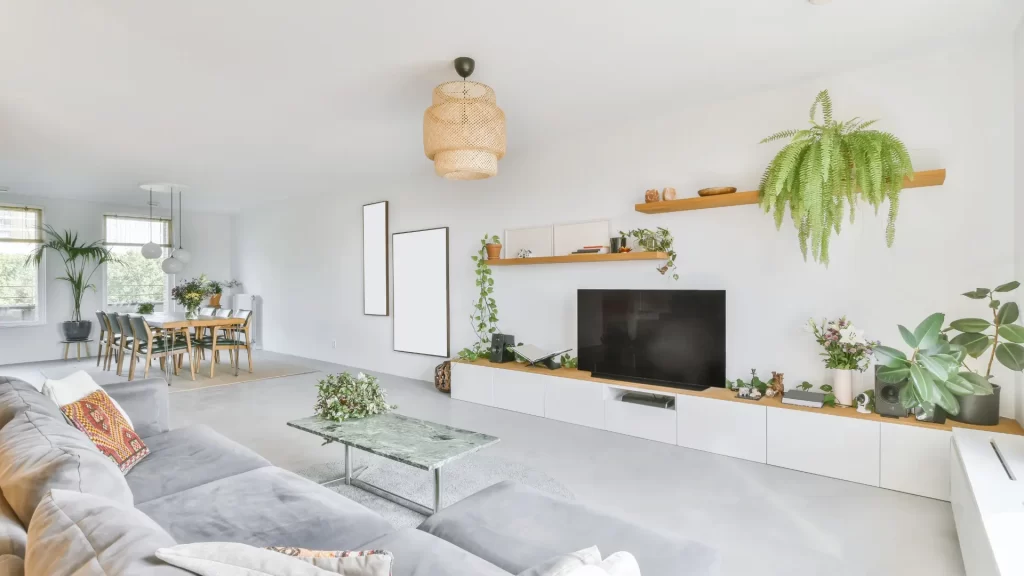
Minimalist Color Palette: Choosing Colors for Serenity and Harmony
In minimalist design, the color palette plays a crucial role in creating a serene and harmonious environment. Here are some key considerations when selecting colors for minimalist homes:
- Neutral Hues: Neutral colors such as white, beige, gray, and taupe are fundamental in minimalist design. These colors create a clean and calming backdrop that allows other elements in the space to stand out. They also reflect natural light well, enhancing the overall brightness of the interior.
- Monochromatic Schemes: Monochromatic color schemes, where varying shades of the same color are used, are popular in minimalist design. For example, different tones of gray or beige can be layered to add depth and visual interest while maintaining a cohesive and harmonious look.
- Limited Color Accents: Minimalist interiors typically feature a limited number of color accents to avoid visual clutter. A pop of color can be introduced through strategically placed accessories such as artwork, throw pillows, or a statement furniture piece. Bold and vibrant colors can create a striking contrast against the neutral backdrop.
- Natural Elements: Incorporating natural elements such as wood, stone, or plants can add warmth and texture to a minimalist space. These natural materials often come in earthy tones that complement the neutral color palette, enhancing the overall sense of serenity and connection to nature.
- Metallic Finishes: Metallic finishes such as chrome, stainless steel, or brass can be used sparingly to add a touch of sophistication and modernity to a minimalist interior. These metallic accents can reflect light and create subtle visual interest without overpowering the space.
- Consider Lighting: The choice of colors should also consider the lighting conditions in the space. Natural light can influence how colors appear throughout the day, so it’s essential to test paint swatches and materials under different lighting conditions to ensure the desired effect.
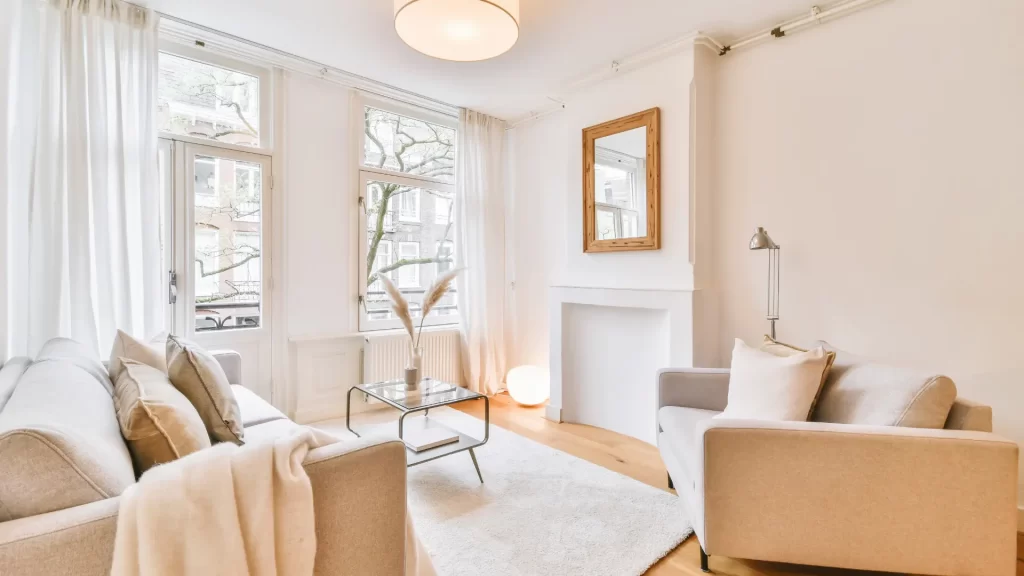
Decluttering and Organizing: Strategies for a Minimalist Living Space
Creating a minimalist living space goes beyond just selecting the right colors and architectural elements. It also involves decluttering and organizing the space effectively. Here are some strategies to achieve a clutter-free and harmonious environment in your minimalist home:
- Keep Only What You Need: The first step in decluttering is to assess your belongings and keep only the items that serve a practical purpose or hold sentimental value. Donate or discard items that are no longer used or needed to reduce visual clutter.
- Create Functional Zones: Designate specific areas for different activities to maintain order and functionality. For example, have a dedicated workspace for productivity, a cozy reading nook, and a serene sleeping area. Each zone should have only essential items related to its purpose.
- Invest in Smart Storage Solutions: Minimalist design often relies on hidden storage solutions to keep clutter out of sight. Opt for furniture pieces with built-in storage, such as beds with under-bed drawers or coffee tables with hidden compartments. Wall-mounted shelves and cabinets can also maximize vertical space while keeping the floor clear.
- Practice the One-In, One-Out Rule: To prevent new clutter from accumulating, follow the one-in, one-out rule. Whenever you acquire a new item, such as clothing or decor, let go of something similar to maintain a balanced and clutter-free space.
- Maintain a Clutter-Free Countertop: In minimalist kitchens and bathrooms, aim to keep countertops free of unnecessary items. Store appliances, utensils, and toiletries in cabinets or drawers to create a clean and streamlined look.
- Regular Decluttering Routine: Incorporate regular decluttering sessions into your routine to prevent items from piling up. Set aside time weekly or monthly to assess and organize your belongings, making adjustments as needed to maintain a minimalist living space.
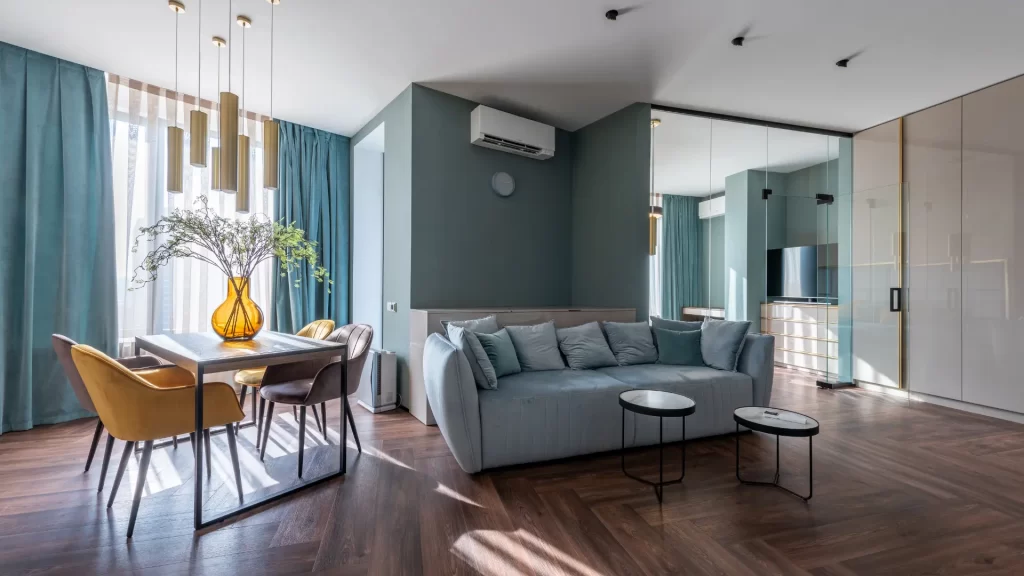
Minimalist Furnishings: Selecting Furniture for Style and Functionality
When it comes to minimalist design, choosing the right furniture plays a crucial role in achieving a harmonious and functional living space. Here are key considerations for selecting minimalist furnishings that blend style with practicality:
- Clean Lines and Simple Designs: Opt for furniture pieces with clean lines and simple designs. Avoid ornate details or excessive embellishments, as minimalist style focuses on simplicity and clarity. Look for sleek and streamlined silhouettes that contribute to an uncluttered aesthetic.
- Functional Versatility: Prioritize furniture that serves multiple purposes to maximize space efficiency. For example, consider a sofa with built-in storage compartments or a coffee table that can also function as a desk. Versatile furniture pieces help reduce the need for excess items in the room.
- Quality Over Quantity: In minimalist design, quality takes precedence over quantity. Invest in well-crafted furniture made from durable materials that withstand the test of time. High-quality pieces not only add elegance to your space but also contribute to a more sustainable approach to home furnishing.
- Neutral Color Palette: Stick to a neutral color palette for your furniture, such as whites, grays, blacks, or earth tones. Neutral hues create a calming atmosphere and allow other design elements, such as artwork or accent pieces, to stand out. Incorporating a limited color scheme maintains visual cohesion in a minimalist interior.
- Space-Conscious Design: Consider the scale and proportion of furniture in relation to your available space. Choose furnishings that fit comfortably within the room without overcrowding or obstructing traffic flow. Opt for space-saving options like wall-mounted shelves or compact dining sets for smaller areas.
- Minimalist Storage Solutions: Look for furniture pieces that offer integrated storage solutions to minimize visual clutter. Cabinets, shelves, and modular units with concealed storage compartments help keep belongings organized and out of sight, contributing to a tidy and uncluttered environment.
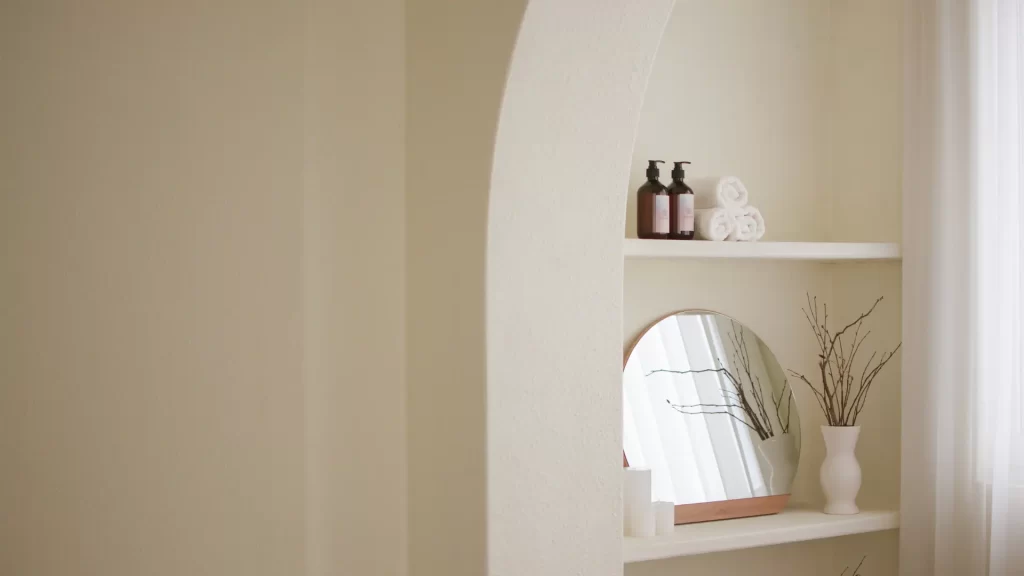
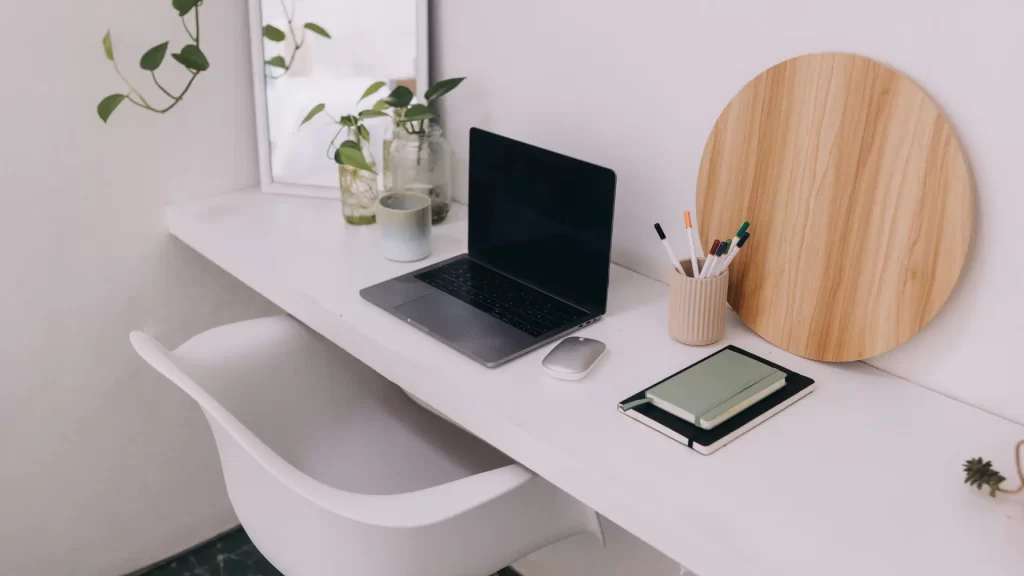
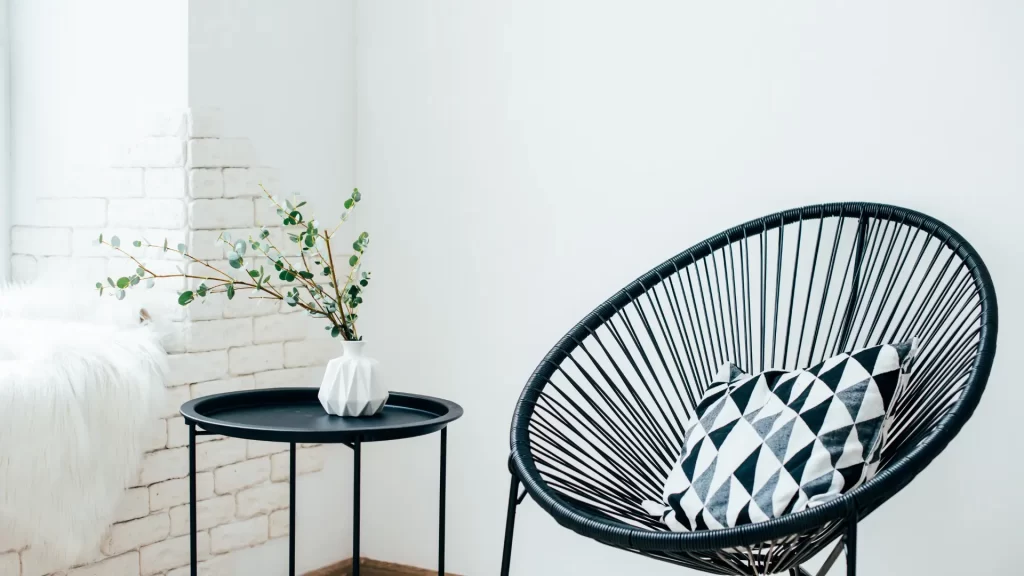
Natural Elements: Incorporating Nature into Minimalist Home Interiors
In minimalist design, the integration of natural elements plays a pivotal role in enhancing the overall ambiance of a space. Here are some effective ways to incorporate nature into your minimalist home interiors:
- Wood Accents: Introduce warmth and texture to your minimalist space by incorporating wood accents. Opt for furniture pieces, such as coffee tables, side tables, or shelving units, crafted from natural wood. The natural grain and tones of wood add a touch of organic beauty while maintaining the clean lines of minimalist design.
- Indoor Plants: Bring the outdoors inside by incorporating indoor plants into your minimalist interiors. Choose low-maintenance plants like succulents, ferns, or snake plants that thrive in indoor environments. Place them strategically in corners, on windowsills, or as tabletop decorations to add a refreshing green element to your space.
- Natural Light: Maximize natural light to create an airy and inviting atmosphere in your minimalist home. Keep window treatments minimal or opt for sheer curtains that allow ample sunlight to filter through. Natural light not only illuminates the space but also highlights the natural textures and colors of materials used in your interiors.
- Stone and Marble: Incorporate natural stone or marble elements to add a sense of luxury and sophistication to your minimalist home. Consider using stone countertops in the kitchen or bathroom, marble tiles for flooring or backsplashes, or even decorative stone accents on walls. The unique patterns and textures of natural stone create visual interest without overpowering the minimalist aesthetic.
- Water Features: Consider incorporating water features, such as indoor fountains or wall-mounted waterfalls, to introduce a calming and serene ambiance. Water elements not only add a sense of tranquility but also contribute to a holistic connection with nature within your minimalist space.
- Natural Fabrics: Choose natural fabrics like cotton, linen, or wool for upholstery, cushions, and curtains. These materials not only offer comfort but also bring a tactile quality that complements the simplicity of minimalist design. Opt for neutral tones or subtle patterns to maintain a cohesive and tranquil environment.
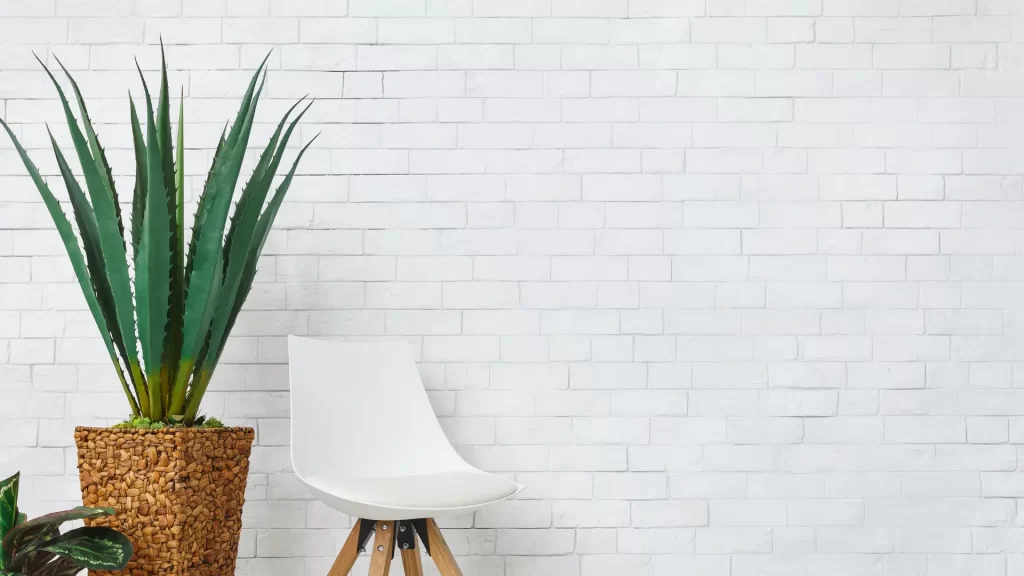
Minimalist Lighting: Illuminating Spaces with Simplicity and Elegance
In minimalist design, lighting plays a crucial role in creating ambiance, highlighting architectural features, and enhancing the overall aesthetic appeal of a space. Here are key considerations and strategies for achieving minimalist lighting in your home:
- Natural Light Integration: Embrace natural light as the primary source of illumination in minimalist interiors. Maximize the use of windows, skylights, and glass doors to allow ample natural light to flood into your living spaces. Natural light not only brightens the room but also creates a seamless connection with the outdoors, promoting a sense of openness and tranquility.
- Clean Lines and Minimalist Fixtures: Opt for lighting fixtures that feature clean lines and minimalist designs. Choose sleek pendant lights, track lighting systems, or recessed LED fixtures that blend seamlessly with the architecture and decor of your home. Minimalist fixtures contribute to a clutter-free aesthetic while providing functional illumination.
- Layered Lighting: Implement a layered lighting scheme to create depth and versatility in your minimalist spaces. Combine ambient lighting, task lighting, and accent lighting to meet different needs and enhance the functionality of each area. For example, use recessed lights or flush-mount fixtures for general ambient lighting, task lamps for focused work areas, and wall sconces or spotlights to highlight architectural elements or artwork.
- Neutral Color Temperature: Opt for lighting with a neutral color temperature, such as soft whites or daylight hues, to maintain a cohesive and calming atmosphere. Avoid harsh or overly warm tones that can disrupt the minimalist aesthetic. LED lighting offers energy-efficient options with customizable color temperatures to suit your preferences.
- Lighting Control Systems: Consider installing lighting control systems or smart lighting solutions to customize and adjust the intensity and color of light throughout your home. These systems allow you to create different moods, enhance energy efficiency, and adapt to changing lighting needs based on the time of day or activities taking place.
- Minimalist Light Fixtures: Choose light fixtures that complement the minimalist style, such as slim-profile floor lamps, pendant lights with geometric shapes, or wall-mounted fixtures with clean silhouettes. Avoid ornate or overly decorative lighting designs that can detract from the minimalist aesthetic.
Outdoor Minimalism: Extending Minimalist Design Principles to Your Outdoor Spaces
Minimalist design principles are not limited to the interior of your home; they can also be applied effectively to your outdoor spaces. Here’s how you can embrace outdoor minimalism and create a harmonious extension of your minimalist lifestyle:
- Simplicity in Landscape Design: Start by simplifying your landscape design to create clean and uncluttered outdoor areas. Opt for minimalist garden layouts with clean lines, geometric shapes, and a limited color palette. Incorporate native plants and low-maintenance vegetation to achieve a natural yet minimalistic look.
- Functional Outdoor Furniture: Choose outdoor furniture pieces that align with minimalist aesthetics. Opt for sleek and streamlined designs made from durable materials like metal, wood, or weather-resistant synthetic materials. Focus on quality over quantity and select furniture that serves a functional purpose while maintaining a minimalist visual appeal.
- Neutral Color Scheme: Maintain a neutral color scheme for your outdoor spaces to create a sense of calm and cohesion. Use muted tones such as whites, grays, and earthy hues for your furniture, cushions, and outdoor decor. Avoid overly bright or contrasting colors that can disrupt the minimalist ambiance.
- Open and Airy Layouts: Emphasize open and airy layouts in your outdoor areas to enhance the feeling of spaciousness and tranquility. Keep pathways clear and unobstructed, and create designated zones for different activities such as dining, lounging, and gardening. Use minimalistic hardscaping elements like gravel, concrete, or natural stone for pathways and patios.
- Minimalist Outdoor Structures: If you include structures like pergolas, gazebos, or outdoor kitchens in your outdoor space, opt for minimalist designs that complement the overall aesthetic. Choose simple, clean lines and avoid excessive ornamentation or decorative elements. Incorporate natural materials like wood or bamboo for a harmonious connection with nature.
- Strategic Lighting: Extend your minimalist lighting approach to your outdoor spaces by using strategic lighting techniques. Install discreet and energy-efficient outdoor lighting fixtures that highlight key areas such as pathways, seating areas, and architectural features. Use soft, diffused lighting to create a cozy ambiance without overwhelming the space.
- Decluttered Outdoor Accessories: Limit the number of outdoor accessories and decor elements to maintain a clutter-free environment. Choose a few statement pieces or focal points that align with minimalist sensibilities, such as a minimalist sculpture, a simple water feature, or strategically placed potted plants.
